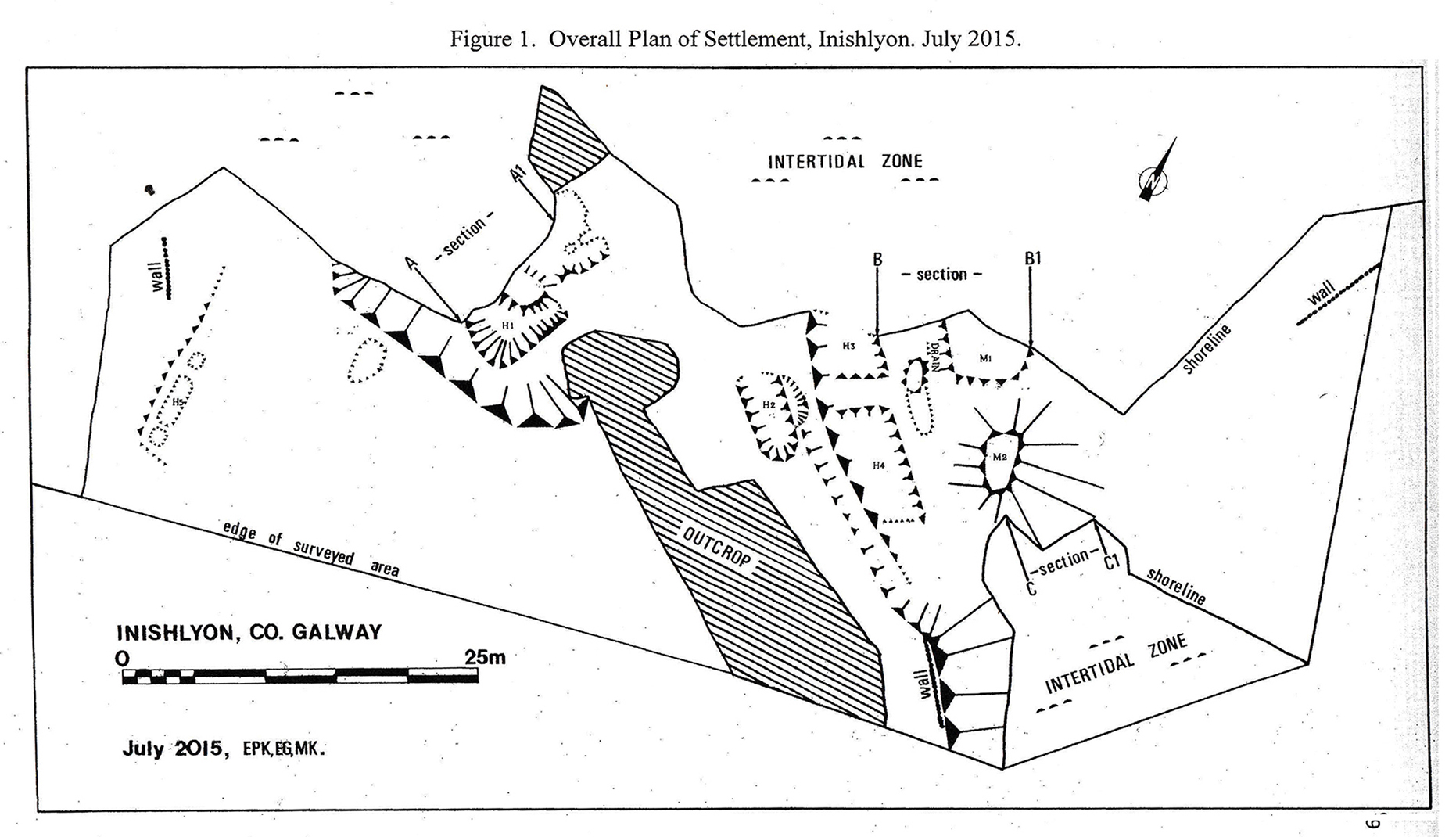County: Galway Site name: Inishlyon
Sites and Monuments Record No.: GA 009DO38 Licence number: 15E0306
Author: Erin Gibbons
Site type: Sunken village
Period/Dating: —
ITM: E 455928m, N 764758m
Latitude, Longitude (decimal degrees): 53.612815, -10.177428

A total of 15 days were spent from 2015 - 2017undertaking rescue excavation, sampling and survey on Inishlyon, an uninhabited island east of Inishbofin, County Galway. The settlement, built on sand which was subject to erosion, appears to be the remains of a 19th-century sunken kelp village with associated kelp kilns, walls and middens.
A series of seven sunken structures and two mounds containing midden material were planned, including some low field walls used for drying kelp. The two mounds containing midden material were sampled. One of the sunken buildings (H1) was also investigated in 2015. A licensed metal detecting survey was also conducted but the signal was interrupted by the high metal content of the underlying bedrock.
In 2016 the remaining part of (HI) was investigated and drawn.
In 2017 the second sunken building (H2) was investigated.
House 1 is orientated east-west, and built in sand with rock outcrop surrounding it to the east and south. The shore is located immediately to the west of it. Three kelp kilns (one rectangular and two circular) are located 20m to the south-east of (H1) (see (K) on the plan). A cluster of three sunken buildings (H2), (H3), (H4), situated 15m to the north-east of (H1), are orientated north-west/south-east. The long axes of the two mounds containing midden material, (M1) and (M2), have the same orientation. The four sunken buildings (H1-H4) appear to be small houses, partly sheltered from the prevailing south-westerly winds by rock outcrop. Three of these buildings (H2-H4) and the two mounds containing midden material (M1-M2) are located at shore level immediately above a shingle beach.
The exposed faces of the middens were sampled in 2015. Midden 1 is a low mound, truncated by erosion on its north-west face. It is located immediately east and north-east of the cluster of sunken buildings and contains at least two phases of use. Midden 2 is also a low mound, which is being removed by encroaching tides from the south-east. Pottery from the upper layer of Midden 1 indicates a 19th-century date for that midden and similar pottery was found in Midden 2. The middens also produced quantities of shell, fish bone, bird bone, iron fragments and small amounts of cattle and sheep bone were also found. There is an undated underlying layer containing midden material which is visible in places over a distance of 35m along the shore.
House 1
In 2016 further investigation was undertaken on House 1.The sidewalls act as internal stone-facing for the sandy pit in which the house is built. There is a ramped entrance in the north wall. A hearth was present near the entrance which contained a fragment of spongeware pottery dating from the 1870s. The floor is made of compacted sand. Two iron sickle-shaped implements found in the house may have been used to cut seaweed. The partly disturbed bones of a sheep were found in a secondary context in the house.
House 2
House 2 was investigated in 2017. It was an eroding, single-roomed sunken structure of similar construction to House 1, but slightly narrower. Rectangular in plan, of random-coursed, dry wall construction, it has a compacted sandy floor similar to House 1. Although the end wall at the north-west was partly removed by erosion, the work revealed the wall foundation course and a narrow entrance together with an area of dark-brown sand which extended westwards from the entrance. A post-hole that held a door post was also uncovered. A fragment of spongeware pottery was found by the doorway, within the house. A series of small hearth spreads were present in various locations along the bases of the surviving walls. It is proposed to undertake further investigative work on the site.
Damhros, Letterard, Cashel, Co. Galway.